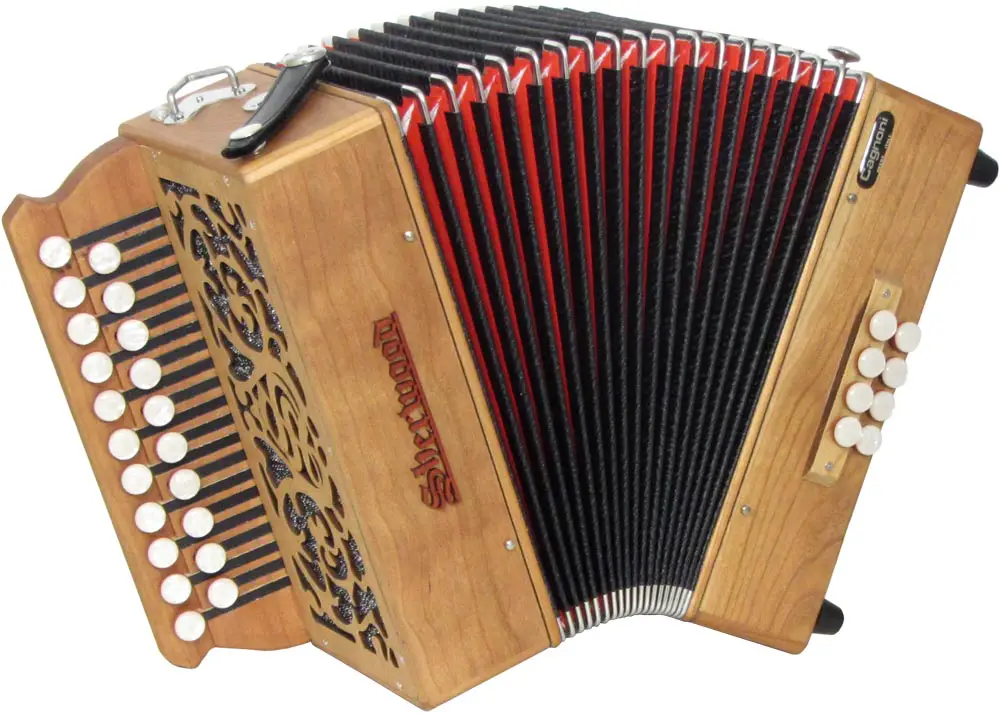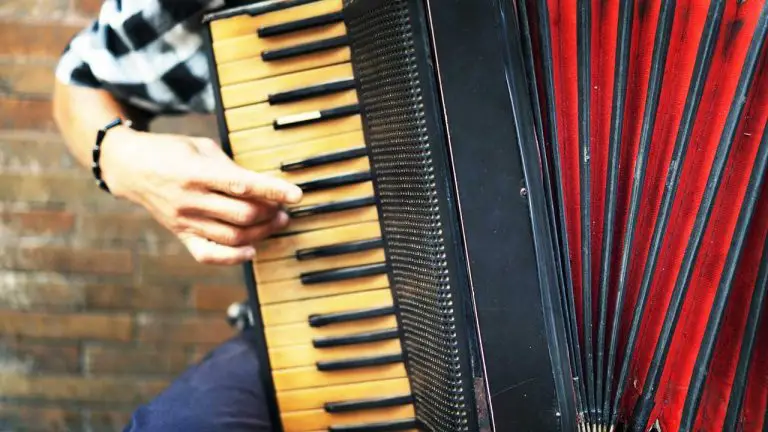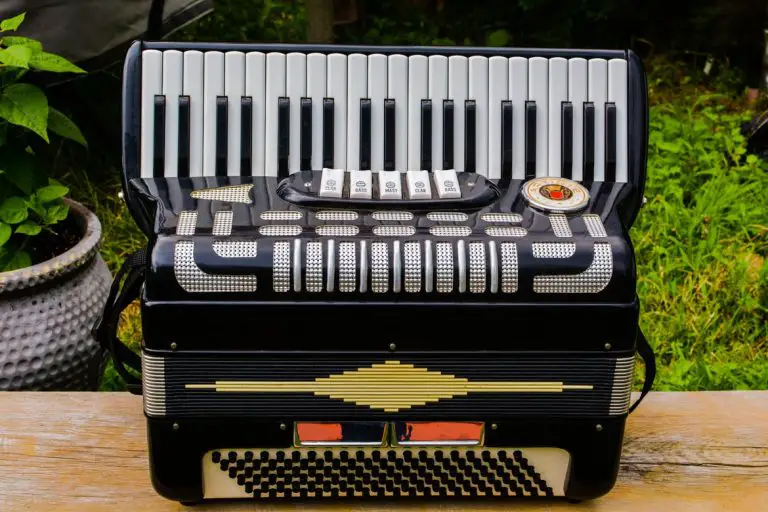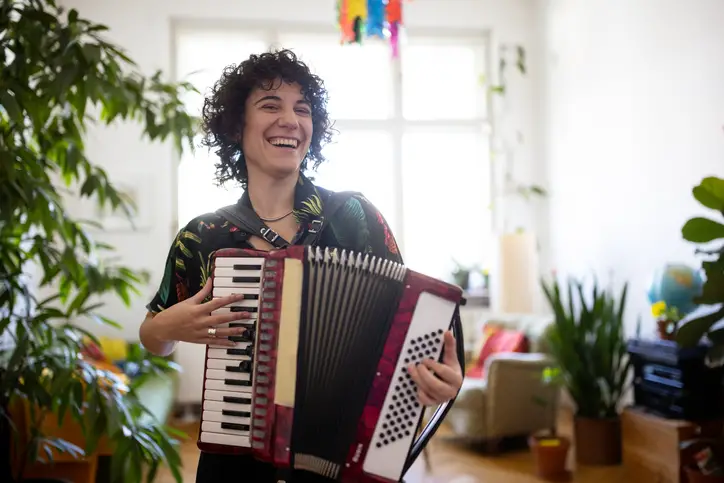What is the Difference Between the Melodeon and Accordion? – The Complete Guide
Folkstrings.com is reader-supported. When you buy through links on our site, we may earn a small commission.
At first glance, it is easy to confuse melodeons and accordions because they look so much alike. Although these instruments are similar, there are key differences that differentiate them. I am here to tell you about these differences.
Melodeons and Accordions Belong to the Same Family
One reason many people get the melodeon and accordion instruments confused is because they come from the same family. Both instruments are in the accordion family but they are separate instruments and play differently.
Table of Contents
- What Is the Melodeon?
- What Is the Accordion?
- What Are The Similarities of the Melodeon and Accordion?
- What Is the Difference Between the Melodeon and Accordion?
- Accordion or Melodeon – Which One Should You Learn to Play?
- Who are Some Famous Accordion and Melodeon Players?
- Tips for Playing the Accordion and Melodeon
- Melodeon or Accordion – Choose the Right One for You
What Is the Melodeon?

Melodeons are accordion-like instruments that have separate keyboards and reeds. This instrument was invented in England, and the word melodeon comes from the Greek word “melos”, which means melody and “eiden” which means to play.
Melodeons are small and bellow-driven. The piano keys are on the right side of the instrument, and the buttons for playing the melody are on the left.
What Is the Accordion?

Musicians often refer to accordions as squeeze boxes. German Christian Friedrich Ludwig Buschmann invented the accordion in 1822. Accordions are more popular than many people realize because they are highly versatile and make sounds similar to multiple instruments, including the saxophone, clarinet, and oboe.
Accordions are also popular because they are fairly inexpensive and easy to pick up and play. You can typically find a mid-range accordion for around $200, which is much less expensive than other instruments that can cost thousands.
What Are The Similarities of the Melodeon and Accordion?
One of the primary things that are similar with melodeons and accordions is that they are both squeeze box-type instruments. Although the setups are different with the two, both are essentially squeeze box instruments.
The keyboard layout for an accordion is like a piano, with rows of buttons that play the notes when they’re pressed. On a melodeon, the reeds are all on one side where they can’t be seen or played as easily as with an accordion. But at their core, both instruments are squeezeboxes.
What Is the Difference Between the Melodeon and Accordion?
These instruments have differences, and it is essential to understand them if you plan on choosing between the two.
The following offers information on how these instruments are different.
- Melodeons are typically smaller than traditional accordions.
- Most musicians consider the melodeon easier to play than the accordion.
- Accordions are more popular than melodeons, mainly because the melodeon is mostly found in European countries.
- The accordion has a piano-style keyboard, while the melodeon has buttons on the keyboard.
- Melodeons are less flexible than accordions.
- Melodeons are also usually lighter than accordions.
- Melodeons are often referred to as a diatonic button accordion.
- The melodeon is more limited on chords.
Accordion or Melodeon – Which One Should You Learn to Play?

If you talk to musicians, you are going to hear a lot of differing opinions. While opinions are good to get you started, including mine, they are just that — opinions.
Many people will tell you to go with the accordion because it offers a lot more song choices. Some say the accordion is also easier to learn.
Traveling musicians will tell you melodeons are better because they are lighter and more portable. Some beginner musicians prefer melodeons because of their light weight.
If you have any experience playing the piano, the piano accordion is likely going to be your first choice. It will feel like a natural transition between the two instruments, and you may find it easier to pick up.
If you have never played on accordion-type instrument, try the melodeon first. Melodeons are fun to play, and you can create all sorts of unique sounds.
Of course, you could always learn to play both. Since they are similar in some ways, learning one will help you understand the other.
Is the Accordion Hard to Learn?
Who are Some Famous Accordion and Melodeon Players?
While the accordion is more widely used than the melodeon, there are famous players of both. You have likely heard of many of these and may have even seen them perform.
- Lawrence Welk
Lawrence Welk is one of the most famous accordion musicians. While he was raised on a North Dakota farm, his parents only spoke German. Lawrence did not learn English until young adulthood.
Lawrence dropped out of school in the fourth grade and decided he wanted a career in music, so he started taking accordion lessons from his father. Eventually, Lawrence became the star of the hit television show The Lawrence Welk Show that aired from 1955 to 1971. Lawrence became a masterful accordion player.
- Weird Al Yankovic
Alfred Matthew, better known as Weird Al, is also a highly influential accordion player. Known for his funny songs that make light of pop culture topics, Weird Al loves the accordion and is a masterful player, even when he is singing silly songs.
Weird Al often performs polka medleys of famous songs and includes them on his albums. One of his favorite accordions is the Roland’s FR-7 V.
- Myron Floren
Myron Floren is said to be one of the finest accordion players who ever lived. He started playing at the age of six. He eventually became an accordion teacher. Later in his career, he became one of the stars of The Lawrence Welk Show. He also created several polka compositions that are still beloved today, including, “Beer Barrel Polka”.
- Loreena McKennitt
Loreena McKennitt is a Canadian singer and songwriter who is well known for her impressive accordion playing skills. Her playing style features Celtic and folk influences, and she once studied classical music and dance. Her last album was released in 2018.
- Bruce Hornsby
Bruce Hornsby is another famous accordion player. Not everyone knows how much Bruce loves to play the accordion. He would often join The Grateful Dead on stage and play accordion. He also has album content featuring his accordion playing.
- Andy Cutting
Andy Cutting is an English folk musician who plays melodeon and composes music. He has appeared on approximately 50 albums and has won the Folk Musician of the Year award three times.
Andy began playing the Melodeon in his early teens. He has written countless songs and continues to shine as a Melodeon artist.
- Brian Peters
Brian Peters is an English folk singer who plays many instruments, including the melodeon. Brian Peters is honored with being one of the leading English Melodeon players. He is also the melodeon player featured on the cartoon SpongeBob SquarePants.
- Saul Rose
Saul Rose is another famous English melodeon player. Saul was born in Harrow and picked up the melodeon when he broke his leg and was bored. At the age of 11, he was taught his first few songs by his father. Saul has played with multiple bands and won awards for his music.
- Tim Van Eyken
Tim van Eyken is an English melodeon player of Belgian descent. He learned to play the melodeon while on the Beetlecrushers clog dance team. In 2008, he appeared in War Horse by Michael Morpurgo.
Tips for Playing the Accordion and Melodeon
Melodeons are often referred to as diatonic button accordions. Because the melodeon is a member of the accordion family, some of the same tips will help you play both as a beginner.
- When playing the melodeon, your left hand goes through the strap, which is called the bass side.
- Your thumb needs to rest on the air button, which is the button in front of you.
- Most people play the melodeon with two shoulder straps to ensure it remains secure. People also use one strap per shoulder to balance the weight of the melodeon.
- When playing, keep the right hand very still and hold the instrument against your body.
- There are 21 treble buttons on the right side of the melodeon.
- Practicing the home button is essential for playing the melodeon.
- Memorize the melody keys on an accordion to play with fluidity.
- Use the register switches on an accordion to change the tone.
- The air valve allows you to let air escape so you can move the bellows without making noise.
- Accordions are placed against the chest with the buttons facing away from you while playing.
- Practice good posture while playing the accordion or melodeon to avoid back pain and ensure your playing style is powerful.
Melodeon or Accordion – Choose the Right One for You
Both the accordion and melodeon are very similar in appearance and playing style. Many people say the accordion is easier to master, but this is not always the case.
Some people prefer learning the melodeon because it is lighter and has fewer buttons to master.
No matter which you choose, both instruments lend themselves nicely to all types of music, including folk and polka. If you can’t decide between the two, why not learn to play them both?
Comment below, which one are you leaning towards?
Author Profile
-
Daniel Johnstone is an English writer with a love for stringed instruments from around the world.
He shares his love for these instruments through his writing for folkstrings.com, a website dedicated to all things related to folk string music.
Daniel's passion for music started at a young age, and he has since become an accomplished musician, playing guitar, cavaco, and recently, the harp.
His dedication to learning and sharing his knowledge of stringed instruments is evident in his insightful and engaging blog posts. Whether you're a seasoned musician or a beginner, Daniel's writing is sure to inspire and entertain you.
When he's not playing music or writing, you can find Daniel exploring new instruments and seeking out new sounds to share with his readers.
Latest entries
 AutoharpApril 4, 2024What Is the Autoharp Made Of: Exploring Its Materials and Craftsmanship
AutoharpApril 4, 2024What Is the Autoharp Made Of: Exploring Its Materials and Craftsmanship AutoharpApril 4, 2024Is Autoharp Easy to Play? Unveiling the Truth for Beginners
AutoharpApril 4, 2024Is Autoharp Easy to Play? Unveiling the Truth for Beginners AutoharpApril 4, 2024What Is an Autoharp Worth? Your Guide to Pricing and Value
AutoharpApril 4, 2024What Is an Autoharp Worth? Your Guide to Pricing and Value AutoharpApril 4, 2024Are Autoharp and Zither the Same Thing? Unraveling String Instrument Myths
AutoharpApril 4, 2024Are Autoharp and Zither the Same Thing? Unraveling String Instrument Myths
Affiliates:
This post may contain affiliate links that at no additional cost to you, the site may earn a small commission. We only recommend products we would use ourselves and all opinions expressed on this site are our own.
Accuracy Advice:
While we strive to provide up-to-date and accurate information, the content in this article may not reflect the most current research or medical guidelines. We encourage readers to do further research and consult with professionals for more personalized advice.
Our Recommendations:
The products and services mentioned in any of our articles are recommended based on our independent research and personal experience. We are not sponsored by any company. We aim to suggest products and services we believe are of high quality and could be beneficial to our readers.





